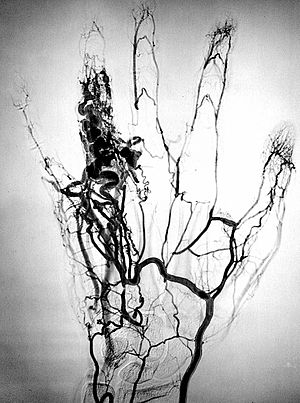Angiography facts for kids
Angiography (say "an-jee-OG-ruh-fee") is a special medical test that lets doctors look inside your blood vessels. Think of it like taking a picture of the tiny tubes that carry blood all over your body. Doctors use different ways to do this, like X-rays or powerful magnets (called MRI). This helps them find out if there are any problems with your blood flow.
Contents
What is Angiography?
Angiography is a medical imaging technique that helps doctors see the inside of your blood vessels. These vessels include arteries, which carry blood away from your heart, and veins, which bring blood back to your heart. When doctors specifically look at arteries, they might call it arteriography (say "ar-tee-ree-OG-ruh-fee").
Why Do Doctors Use Angiography?
Doctors use angiography to check for different problems with blood vessels. It's like a detective tool for your circulatory system.
- Finding Blockages: Sometimes, blood vessels can get blocked or narrowed, making it hard for blood to flow. Angiography can show these blockages.
- Checking for Aneurysms: An aneurysm is a weak spot in a blood vessel that can bulge out like a balloon. Angiography helps doctors find these.
- Looking at Blood Flow: It can show how well blood is flowing to different parts of your body, like your heart, brain, or legs.
- Planning Treatments: If a problem is found, angiography helps doctors plan the best way to fix it, whether it's with medicine or a procedure.
How Does Angiography Work?
There are a few main ways doctors perform angiography:
X-ray Angiography
This is the most common type.
- Contrast Dye: First, a special liquid called a "contrast dye" is injected into a blood vessel, usually in your arm or leg. This dye makes the blood vessels show up clearly on X-ray images.
- X-ray Pictures: As the dye travels through your blood vessels, doctors take a series of X-ray pictures. These pictures show the dye moving, outlining the vessels and any areas where blood flow might be slow or blocked.
- Real-time View: Sometimes, doctors use a special X-ray machine called a fluoroscope, which creates a live, moving X-ray image on a screen. This allows them to see the blood flow in real-time.
Magnetic Resonance Angiography (MRA)
MRA uses a powerful magnetic field and radio waves instead of X-rays.
- No Radiation: Unlike X-rays, MRA does not use radiation, which can be a good option for some people.
- Detailed Images: It creates very detailed 3D images of blood vessels and surrounding tissues.
- Contrast or Not: Sometimes, a special contrast material is injected, similar to X-ray angiography, to make the images even clearer. Other times, it can be done without any injection.
Computed Tomography Angiography (CTA)
CTA uses a special type of X-ray machine called a CT scanner.
- Fast Scans: CT scans are very fast and can take many images in a short time.
- Detailed Cross-Sections: It creates detailed cross-sectional images (like slices) of your body, which can then be put together to form 3D pictures of your blood vessels.
- Contrast Dye: A contrast dye is usually injected to highlight the blood vessels.
What Happens During the Procedure?
- Preparation: You might be asked not to eat or drink for a few hours before the test. Doctors will explain everything and answer your questions.
- Injection: For X-ray or CT angiography, a small tube (called a catheter) is often inserted into a blood vessel, usually in your groin or arm. This is how the contrast dye is put into your body. You might feel a slight pinch when the area is numbed.
- Taking Images: You will lie on a special table, and the imaging machine will take pictures. You'll need to stay very still.
- After the Test: After the test, the catheter is removed, and pressure is applied to the injection site to prevent bleeding. You might need to rest for a few hours.
Is Angiography Safe?
Angiography is generally safe, but like any medical procedure, there are a few things to be aware of.
- Allergy to Dye: Some people might have an allergic reaction to the contrast dye. Doctors always check for allergies beforehand.
- Bruising: You might have some bruising or soreness where the catheter was inserted.
- Radiation: X-ray and CT angiography use a small amount of radiation. Doctors always use the lowest amount needed to get clear images.
Angiography is a very helpful tool that gives doctors a clear view inside your body, helping them understand and treat problems with your blood vessels.
See also
 In Spanish: Angiografía para niños
In Spanish: Angiografía para niños


